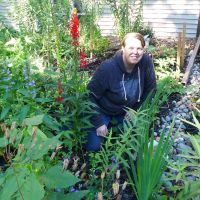Neighborhood Spotlight: Ahi
As a new homeowner, Ahi has learned many new skills on the go. With a passion for gardening, this was her first property where she could really dig in and explore, trying new things and cultivating a vision for her new home. With a yard that was struggling as conventional turf, she had a hefty amount of shade to work with. But with a certain perspective, it morphed into a blank canvas for opportunity! VLAWMO enjoyed witnessing Ahi’s journey, steadily gaining skills such as how to space native plants and nurture them in their early stages. Using books, web resources, conversations with a nearby neighbor who was also installing a raingarden, and a new practice of observing how runoff moves during rain events, Ahi is now a neighborhood leader with experience to share and stories to tell. The only question is, “how many plants are too many?” We caught up with Ahi one year after her project was installed to hear how it’s going.
Raingarden Chat with Ahi
What motivated you to go in this direction for your yard?
After purchasing my house in late 2019 I was on a mission to beautify the place. I have a passion for gardening and the yard was just half-dead grass and weeds - not at all appealing.
While lamenting about the deplorable state of my yard, a friend mentioned a grant that I could apply for to get reimbursed for putting in a raingarden populated with native plant species. That’s where my whimsical, meandering, yet rewarding, journey began.
How would you describe your creative design process – was it a big vision or pieced together as you went along? What resources helped?
In truth the final design approved for the grant turned out vastly different from the original concept sketch I drew up. I made some mistakes with that initial design that needed to be corrected. The basin was originally too close to the house so it was moved back, and a neat dry creek feature was added to take the raingarden overflow. Due to my excitement, the project took on a life of its own and it grew, more than doubling the size I had originally planned on rehabbing. This worked around the VLAWMO grant so long as I kept the chunk identified in the application separate in terms of costs, space, and plants. Everything beyond that was my own doing. I relied heavily on resources from VLAWMO staff and conversations with the local native plant nurseries.
How did the raingarden blend into your existing yard and drainage set-up?
The plan was not so much to blend in as to completely revamp the front yard. The previous owners of the house had not done much of anything with the yard and it was in bad shape, an eyesore, really. The only pre-existing infrastructure that remains from the original state of the yard is the rock bed directly in front of the house and the downspout at the far corner. This downspout was extended to drain directly into the raingarden basin.
Has the raingarden inspired any other similar projects?
Oh boy, where to even start? I suffer from the problematic habit of starting projects and never quite finishing them. In the backyard at present I have six gardens in varying stages of completion, the largest of which takes up about half the yard and is all shade courtesy of some monster-sized silver maples. As far as native-type plantings, I added some sedges at the outlets of my downspouts in the back to help control runoff from those spots.
How has the raingarden changed your interaction with your yard? Any favorite sightings or things you’ve noticed?
I take so much more enjoyment from my yard now that the raingarden is there. I included a path that goes through the middle of it for multiple reasons: weeding accessibility, the mail carrier’s use, and so that I can walk into my garden and be surrounded by plants. The flowering species - especially the anise hyssop - have become large draws for bees, which I hardly ever saw in my yard before. I enjoy watching the bumblebees tending the flowers and listening to their buzzing. I’ve also had some dragonflies hanging around, including one distinct character that will hover in one spot for a very long time and refuses to move aside even if you walk towards it. But by far my most cherished encounter was when a hummingbird stopped by to sip at the cardinal flowers.
And the compliments - I get so many from passersby! All my hard work has definitely paid off in beautifying my property and the people in my neighborhood are definitely taking notice. It’s a great feeling!
Any advice for other folks who may be interested in a raingarden or shade planting?
Do your research! I knew nothing about raingardens going into this project and there was definitely a learning curve. Also, stem your enthusiasm; Rome wasn’t built in a day, and your garden doesn’t have to be complete in a single season, either! (Unless you’re applying for a grant then, yes, you have 1 year!) Start small and simple and leave room to expand because it’s definitely an addiction. Some folks may not want to keep expanding, but if you’re like me you’ll probably be wishing for a larger yard! Even if you have a shady yard like I do, don’t feel like that means you can’t have a garden. You just need to seek out the shade-tolerant plants and plant to your yard’s conditions. Lastly, remember that every garden is unique and that’s what makes them beautiful. I learned early on that one of my nearby neighbors was working on a raingarden for the same grant. We got to talking and a friendship developed as we compared plans, discussed basin depth and angles, and plant choices.


